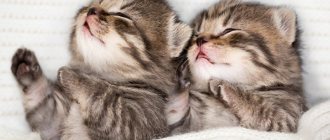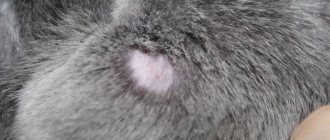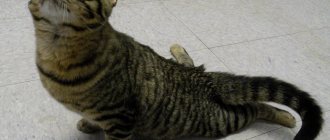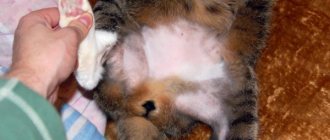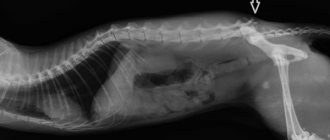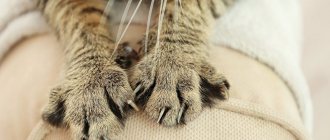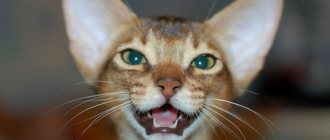Reasons why a cat trembles
Tremor or trembling in a pet is not always a sign of illness. If a cat is trembling, then it is almost impossible not to notice this state of the animal. There are several main reasons that can cause a pet to tremble in apparent absolute health:
- an animal's reaction to an external stimulus represented by cold. This reason is the most harmless, but can cause a number of quite serious consequences, including severe hypothermia of a pet. It is especially important to control the temperature in the room when keeping hairless breeds and cats with short hair. In cool weather, it is necessary to reduce walks with the animal to a minimum or completely eliminate its stay on the street;
- an animal's reaction to severe fright or any stressful situation. Quite often, this situation arises when there is a sudden change in diet, the appearance of strangers or unfamiliar animals in the house, as well as when being transported to a new place of residence. In this case, it is enough to eliminate all factors that provoke trembling as quickly as possible and calm the pet;
- reaction to a joyful event. Trembling in an animal can also cause quite positive emotions, including joy from the appearance of the owner or pleasure from games, affection and receiving favorite foods;
- reaction to sexual arousal. The appearance of fairly distinct trembling can be caused by a state of sexual arousal in a cat or a cat in heat. In almost all representatives of the cat family, all senses are very characteristically heightened and behavioral characteristics change greatly during the period of sexual arousal, therefore, it is advisable to sterilize or castrate animals not intended for breeding;
- natural processes. Actively occurring in the body of a sleeping pet, they can also be accompanied by trembling of the body and limbs.
Important! Particular attention is required to frequent, quite strong tremors of the body and limbs, which occur in a pet regularly and for no apparent reason.
In this case, it is necessary to deliver the cat to a veterinary institution as quickly as possible, where a full range of basic, most informative diagnostic measures will be carried out aimed at identifying the cause of the pathological condition.
Why is the cat shaking?
There are many reasons why cats tremble. This may be a manifestation of fear, the influence of cold, an uncomfortable body position.
Puberty in cats is one of the most common causes. After sterilization, the trembling stops. In cats, this phenomenon can occur before estrus. If symptoms persist after surgery, be sure to contact your veterinarian.
A lack of vitamin B can also cause tremors in your pet. In this case, buy brewer's yeast for your cat. They are sold at any pet store.
Don't worry if your cat twitches in his sleep - this is a normal phenomenon that occurs during sleep.
A kitten's active sleep is not a reason to worry
Most of the speculation surrounding the concern comes from kitten owners. We dare to assure you that if your cat twitches in his sleep, but he is not yet 12-15 months old, this is normal. Don't worry if the kitten sleeps in an unnatural position or if its eyes are slightly open. The first is explained by the fact that kittens are not so demanding of comfort, the second is due to the presence of a third eyelid, a transparent film that protects the eye during sleep, even if it is open.
The kitten may twitch violently, roll over, and even meow after stress or active play. If the baby is sleeping and you notice that his paws are twitching, it means that the four-legged animal is walking or running in its sleep. Until 1.5–2 years of age, activity in the REM phase is absolutely normal and is explained by an incompletely formed nervous system.
The REM phase of sleep in kittens up to 6 months takes up about 80% of all sleep time. If you notice that your cat doesn’t startle in its sleep as often as before, you can draw conclusions about the strengthening of the nervous system and the maturation of the animal as a whole. The period of formation of the nervous system is very individual and depends on many factors. In outbred so-called native cats, it lasts up to 10 months; some purebred cats “remain children” for up to two years.
When to contact a veterinarian
If the tremor of the cat’s body, head or limbs is not caused by a physiological condition, then it is very important to carry out an extensive examination of the pet. The following fairly common pathologies require timely and correct treatment:
- trembling of the limbs caused by herpes virus infection or rhinotracheitis of the animal. You can independently identify the pathology in the presence of such basic symptoms as the presence of purulent discharge from the nasal cavity and eyes, as well as cough, vomiting and fever;
- When there is a helminthic infestation or cystitis, the pet shakes its limbs very often, which allows the animal to reduce the feeling of itching and pain. Among other things, tremor occurs due to severe discomfort when urinating;
- systematic or periodic twitching of a cat's head is most often one of the symptoms when an animal is affected by otodectosis or ear scabies. In this case, in addition to twitching, scratching of the affected ear is noted. Visual inspection allows you to see damage to the outer ear and ear canal. This disease requires urgent medical intervention;
- By frequently twitching the head, a pet may be trying to get rid of discomfort due to otitis media or accumulated wax. In the first case, delay in treatment can cause lifelong deafness in the animal or complications in the form of severe organic damage to the hearing organs;
- a cat is capable of shaking its head frequently and quite actively in case of functional disorders, including pathologies of the liver, kidneys and respiratory system. Severe tremor in this case, as a rule, indicates the presence of irreversible damage to internal organs.
Trembling in the croup area of a cat or the presence of generalized tremor in a pet may indicate the presence of various lesions in the spine, which are most often represented by compression fractures, tumors and deformation of the intervertebral discs, as well as spinal canal stenosis. The most severe organic lesions are also accompanied by weakness in the lower extremities and trembling of the animal during any attempt to stand on its feet.
We suggest you read: How many times should you wash your cat with antifungal shampoo?
The rapid development of the disease and the lack of adequate treatment provokes the development of paralysis and sometimes the death of the animal. In some cases, it is possible to stop the attack fairly quickly, but most often the process of treating severe pathologies is lengthy and quite expensive.
If the tremor is accompanied by weakness and severe pain, in which the animal meows loudly and plaintively, and arches its entire body, then it is necessary to exclude poisoning and the entry of any sharp object into the digestive system that can cause severe damage to the mucous membrane, as well as gastric or intestinal bleeding.
Noticing that a cat is twitching in its sleep, the owner may be concerned about the well-being of the pet. If we are talking about an adult cat, suspicions are far from unfounded. Let's figure out why cats twitch in their sleep and what it may indicate if a cat twitches too much.
It was cats, or rather, their dreams, that made it possible to prove to the whole world that animals also plunge into the world of dreams. Moreover, scientists suggest that our pets' dreams are much richer and more dynamic than ours. It all started when doctors began to study the phases of human sleep. To confirm their assumption that healthy people lose the ability to move during REM sleep, an experiment was conducted on a group of cats.
All animals had a small area of the brain removed, which was responsible for muscle atonia in the REM phase of sleep. After the animals were fully rehabilitated, the scientists' suspicions were corrected. The observed cats stood on their paws, walked confidently, and turned their heads, as if watching someone. While in a state of sleep, cats sniffed and turned their ears. The experiment proved that cats see, hear and touch dreams.
https://www.youtube.com/watch?v=bBlDWl9n6mc
These are the main reasons why a kitten may be shaking. If the baby feels generally fine, and there are no other alarming symptoms, and the tremor goes away as quickly as it started, there is no need to worry too much, but it is worth watching the animal.
Paws tremble most often when the cat’s body is infected with the herpes virus or when loryngotrocheitis develops. The main symptoms of such pathologies, in addition to the fact that the cat’s hind legs are trembling, are:
- nasal discharge;
- cough;
- temperature increase;
- lethargy.
Trembling in the paws may also occur due to advanced helminthiasis or cystitis. In such a situation, paw trembling is aimed at relieving discomfort in the abdominal cavity. Treatment for the appearance of pathological tremors should be carried out urgently. Postponing it for days, and moreover, for a month, is unacceptable, as this may pose a threat to the life of the pet. The help of a veterinarian will be necessary.
The reasons that lead to trembling in an animal are numerous.
These are both external factors (toxic substances) and internal diseases.
Trembling limbs
Trembling in the limbs of a pet can be caused by a herpes virus infection or rhinotracheitis of the animal. The main symptoms of this disease are purulent discharge from the nose and eyes, cough, vomiting, and fever.
Head shaking
Quite a few reasons can lead to systematic or periodic twitching of an animal’s head. Frequent twitching may be a sign of otodectosis or ear scabies. In addition to twitching, you can observe how the animal often scratches the affected ear, literally plunging its paw into the ear canal and injuring the tissue. At the same time, the cat may meow pitifully.
Systematic head twitching can be a sign of otitis media, while the cat’s ear hurts and she won’t let it be touched. Or it may be evidence of the formation of sulfur plugs.
Head twitching may indicate liver failure, acute disruption of the respiratory system and even the kidneys. If the functioning of internal organs is disrupted, the disease occurs with a characteristic clinical picture of a particular disorder. Tremor appears already at the stage of organ failure.
Encephalitis, the use of certain medications, vestibulopathy, cerebellar pathologies, and traumatic brain injuries can cause tremors and even seizures.
Lesions of the spine (compression fractures, tumors, deformation of intervertebral discs, spinal stenosis) can lead to weakness of the lower extremities and trembling when the animal tries to stand on its feet. With further development of the disease, paralysis occurs.
Neuromuscular diseases, degenerative neurological pathologies, myelin deficiency, metabolic pathologies and even poisoning by toxins (for example, organophosphates) can cause severe tremors throughout the animal's body.
Caring cat owners carefully monitor their pet’s behavior, noticing in time the slightest changes in their behavior, indicating problems in the animal’s well-being. That is why any uncharacteristic action can serve as a symptom of an illness.
What to do if your cat is shaking? This question worries many breeders who are faced with this sign of a pet’s ill health. Firstly, we can advise you to pay attention to the frequency and intensity of this manifestation. How often does a cat shake? How long does it last? Does the animal's entire body shake or just a certain part of the body?
Are there any additional symptoms of the disease - increased body temperature, hair loss, decreased activity? The answers to all these questions will allow you to establish the truth and suggest what exactly is bothering your pet. However, in many cases, you should not rely on your own observation and basic knowledge of veterinary medicine; you should seek help from a specialist as soon as possible in order to diagnose the disease and prescribe appropriate treatment.
So, if a cat is shaking, then this may be a manifestation of emotions - both positive and negative. The animal may feel chills from cold, fear or extreme joy. In this case, the cat is not shaken for too long, after which the animal continues to behave naturally. The urge to naturally defecate or urinate can also cause your cat to tremble.
Most often this sign is observed in kittens. During puberty, a cat may also shake, and in an adult cat, trembling may be observed before estrus. Sterilizing your cat will eliminate this sign forever. However, if after the operation the cat continues to shake, this is a reason to seek help from a veterinarian.
After sterilization, the cat may shake due to the presence of a blanket on the body. The cat instinctively tries to get rid of a foreign object on its own body, so it periodically shakes, trying to throw off the blanket. Veterinarians usually warn breeders about this after the operation.
We suggest you read: Childbirth in a Scottish Fold cat
A lack of vitamin B in a cat’s body can also cause the pet to periodically tremble. Veterinarians advise adding brewer's yeast to animal feed in order to prevent vitamin B deficiency. It is not difficult to find this remedy in veterinary pharmacies. A cat may twitch in its sleep - this is a normal phenomenon caused by neurochemical reactions in its body during a state of "oblivion."
Trembling limbs
Tremor in a cat
Tremors (tremors) are frequent muscle contractions that persist while awake. True trembling stops during sleep.
Tremor in cats is not always associated with pathology; there is so-called physiological tremors:
- In case of hypothermia
- With emotional stress
- For severe muscle strain/tension
Causes of true tremor
There are many causes of tremors in cats, depending on what part of the body is affected.
Head tremors
- Cerebellar abnormalities
- Idiopathic (cause unknown)
- Genetic causes
- Inflammatory processes (encephalitis)
- Injury
- Use of certain drugs
- Vestibular diseases
Tremor of the back of the body
- Weakness or pain.
- Metabolic disease (kidney failure, low blood sugar).
- Compression lesions of the spine (tumors, narrowing of the lumen of the spinal canal).
- Neuromuscular diseases.
Common Causes of Trembling
- Toxic (organophosphates, mycotoxins).
- Hypomyelination (diseases in which the myelin sheath of the nerves is reduced or absent).
- Degenerative neurological diseases.
Diagnostics
For an initial medical history and blood draw, you can call a veterinarian to your home. A detailed blood test, biochemical profile and urine test are recommended in all cases. It is important to rule out metabolic disorders such as hypoglycemia (low blood sugar) or kidney disease.
Usually, an X-ray examination of the chest and abdominal cavities does not reveal any pathologies, but it should be carried out, as well as an X-ray of the spine.
Myelography (x-ray examination of the spine using dye) may be recommended to evaluate the presence of a tumor or intervertebral disc disease.
A CT or MRI scan can help detect structural changes in the brain and/or spine.
A cerebrospinal fluid tap can confirm encephalitis.
Electromyography will help in diagnosing neuromuscular disorders.
Treatment
How to cure tremors in a cat? It is necessary to identify and eliminate the root cause of this condition, if possible. It is also recommended to avoid agitation and increased activity, as they can worsen the tremors, so it is better to call a veterinarian at home for follow-up examinations. Intervertebral disc disease sometimes requires surgery.
Home care
Avoid exposing your cat to various toxins. If you suspect poisoning, immediately contact your veterinarian or call a doctor at home. Animals with general tremors often lose weight. Monitor your pet's weight and make appropriate dietary changes.
Causes of trembling in a cat
The cat was simply frozen. It would seem that cats can really suffer from the cold, since they can be outside even in the winter? However, in fact, cold is the worst enemy for all living organisms. An animal that has become hypothermic can not only catch a cold, but also become seriously ill.
A problem of this nature can be solved in the following way:
- Do not let the animal go outside in winter.
- Buy clothes for cats in specialized stores, or make them yourself.
If a cat, coming from the street, lies down on the floor, on the sofa, or somewhere else, and at the same time trembles strongly, he is simply very cold during a walk. It is also worth keeping an eye on the animal and during this very walk, it may begin to shake while still on the street.
The cat became scared. The person who believes that cats are the most fearless animals is deeply mistaken. They may show this with all their imperturbable appearance, attacking the feet of their owners, damaging the owner’s property, however, in the very depths of their souls, these animals are very vulnerable and timid creatures: you can scare a cat as easily as possible.
Due to experiencing severe fright, or a stressful situation, which, for example, may be associated with a change of residence, a change in food, or the appearance of a stranger in the house (in fact, there are a huge number of reasons). In this case, a nervous shock may occur in the cat’s body, the result of which will be trembling or nervous chills.
The cat begins to literally shake with fear. What to do in this case? It would be most advisable to try to eliminate the cause in the form of that same provoking factor. The owner will have to try to calm his beloved pet, stroke it, caress it. Every person knows that fear and stress can be eliminated through the use of positive emotions.
If such a cat's tremors are ignored, in the future such an action may lead to a change in the cat's behavior, which may result in habits that irritate the owner.
The cat experiences joy and positive emotions. The pet may tremble while lying down from an excess of positive emotions. The mustachioed man could miss him very much during the whole day of absence of the owner of the house. And when the owner comes home, the cat rushes to climb onto his lap and settle down there comfortably in a ball or stretched out to his full cat height.
Trembling when lying down in this case means exclusively a test of pleasure from the fact that its owner is near him
The cat lies down on the floor after eating and begins to tremble. Veterinarians say that a full stomach can bring a cat to this state; the animal’s muscles simply contract.
The cat is experiencing sexual arousal. When an animal is in such a state, it may experience a tremor of the whole body, which in turn is due to the fact that the cat’s senses are very heightened at a given moment in time and its excitement reaches its extreme measure. In the event that the owner does not intend to breed cats, the correct way to get rid of tremors of this nature will be castration of the mustachioed one.
If the cat owner has determined that the cat has any of these reasons, then there is no need to worry in this case: the cat will calm down and the trembling will go away by itself.
Causes of trembling
If your cat is trembling, you will definitely notice it. Even if it is a rather small trembling, which you may not notice visually under the fur, you will feel it when you touch the pet and stroke it or pick it up. The symptom may manifest itself more intensely. At this time, your pet's paws may twitch a little. It is impossible to confuse the symptom with others, but often the owners do not know what needs to be done in such cases.
There is no need to panic when trembling occurs, but this situation cannot be ignored. If this phenomenon causes you concern, since it occurs frequently and is accompanied by other symptoms, it is still better to show your pet to a veterinarian. But every owner of a cat should still know what reasons can cause trembling. Sometimes finding out the cause and eliminating it successfully eliminates trembling. But in any case, you need to consult a doctor.
Fear
Cats are not only very brave and daring, but also very timid. They are afraid of many things. Trembling may occur due to the fact that the animal has been exposed to some kind of stress. For example, circumstances in his usual life have changed. Some pets cope with change and stress more calmly. For others, it is much more difficult to adapt to something new. Therefore, they can tremble even because you changed their food for another one or a stranger came to visit, who for some reason causes fear or mistrust in your pet. As a result of fear, trembling begins.
You need to understand what exactly caused this reaction in your pet and eliminate its cause. After this, try to calm the animal as quickly as possible. Pick it up, stroke it, try to distract it. Such tremors are best treated with good emotions.
If you do not pay attention to this behavior, then in the future it may affect changes in the pet’s behavior, which may become annoying for you. Therefore, paying attention to caring for your pet and taking care of its emotional state is very important.
Cold
This is the most harmless reason why your pet may be shaking. But even ordinary cold may not have the most harmless consequences.
Hypothermia of your pet's body can lead to a cold. And this is already a cause for concern. It is very important to maintain temperature conditions when keeping cats. This applies most of all to purebred animals with short hair, as well as those who have no hair at all. In winter, such animals need heating. If you see that the animal is trembling, and the temperature in the room is really low, try changing the conditions in which the pet is kept and observe the changes. Perhaps the house just needs better heating.
You can arrange a place for your pet in the warmest place in the house, where he will happily spend time in the winter. If necessary, dress your pet in special clothing. Such clothes do not have to be bought in stores for a lot of money. You can make it yourself using advice from a magazine or the Internet.
If a cat starts shivering while walking on a cold day, most likely the pet is simply cold. Therefore, it is better to stop walking. If your pet does not tolerate the cold well, then it is best to take walks only in warm weather.
Joyful emotions
Trembling can also occur for the exact opposite reason. That is, because of the joyful emotions that the animal experiences. For example, you were not at home all day, and the animal was bored alone. When you come home and he has the opportunity to lie on your lap, this is a real delight for the cat. When a pet finds itself next to its owner after being bored, it may well even tremble with joy. Researchers believe that a cat can tremble even after eating. But not because he rejoices in being full. When the stomach is full, the muscles of the body contract.
Another reason is sexual arousal
The symptom also appears at the time of sexual arousal. During this period, all their sensations are more heightened, they react to everything more strongly. If this feeling is not satisfied, this also leads to stress. If you do not want to specifically breed your pets, it is recommended to spay or neuter them.
When should you worry?
If a cat's paws twitch in its sleep, this is not always a cause for alarm. You should keep an eye on your pet. You need to observe not so much in a dream as at the moment of awakening. The state of the animal is immediately visible: if the cat is happy, she has the perky look of a hooligan or, on the contrary, the mysterious arrogant look of an empress, she stretches and yawns, purrs briefly and abruptly.
You should be concerned if your cat twitches too often during sleep. When your pet looks unhappy, tired and lethargic when waking up, you should immediately contact a veterinarian.
Doctors' help is also required in cases where a cat twitches its paws in its sleep and then wakes up sweaty and with wet fur. This is a symptom of internal problems in the body, which may be related to hormonal balance or kidney function.
Persians who eat dry food often suffer from kidney failure and urolithiasis. Persian cats prone to such ailments always first begin to twitch and sweat, and only after some time do characteristic symptoms appear - changes in the concentration, color and smell of urine.
When observing a sleeping twitching cat, you need to carefully touch it, trying not to wake the pet. This should be done in order to understand whether the animal has a cramp - contraction of muscle fibers. It is impossible to determine this visually. If your pet's body or legs are cramping, you should immediately consult a doctor.
We suggest you familiarize yourself with: Scottish Straight Longhair cat
When do you need a veterinarian?
The veterinarian will examine the animal and prescribe the necessary tests. As a result, it may turn out that the pet has diseased kidneys. Along with trembling, the pet becomes more aggressive and its behavior changes.
There is another reason why trembling may begin. And she's pretty serious. This is rhinotracheitis. This disease can affect both an adult animal and a kitten. It can develop in representatives of any breed. With this disease, the pet's respiratory system is affected.
In order to identify a disease in your pet as early as possible and begin to treat it, it is better to show it to the veterinarian as soon as you become suspicious and concerned. If your suspicions are not confirmed, you can calm down, and if they are confirmed, you will have a better chance that your pet will recover faster, and this will not affect his health.
An attentive owner of a mustachioed, striped, and perhaps completely hairless meowing pet (we are talking about) will definitely notice the changes that are happening to his animal. But how to react to them? Should you always bother your veterinarian? Or perhaps the symptoms that frighten us are not some kind of terrible pathology?
Today we invite you to talk about why a cat or cat may tremble, what diseases such trembling can be a symptom of, and how to help an animal in this situation
…
What else causes twitching?
A sleeping cat may twitch for a variety of reasons. In order for the doctor to be able to narrow down the range of possible sources of this phenomenon, careful observation of the pet is required.
The presence of muscle spasms, severe convulsions, and contraction of the limbs is always a signal of a serious illness. Unlike simple fingering and reflexive twitching of the paws, this condition is not caused by a dream or stress.
If a cat, the causes of this condition may be hidden in the reality around it, that is, stress may be the source of the twitching. Each animal has its own stress tolerance threshold, just like humans. Some cats are extremely emotional and very susceptible to the slightest negativity. For such animals, a rude word, inattention from the owners or being thrown aside, even a potty that is not cleaned in a timely manner and a bowl that is not washed can cause anxiety and nervous breakdown.
Siamese and Burmese are the most inclined to dramatize everything that happens around them, but Persians are cats with a stable nervous system.
Animals endowed with sociable character traits, but forced to spend the whole day locked up alone, are also prone to stress and psychological distress. For such a cat, the owner’s return from work is a great and long-awaited joy; if a person shows dissatisfaction, the animal is sincerely upset and does not understand what it has done wrong. Several such cases lead the pet to chronic stress, which subsequently develops into prolonged depression.
What causes seizures?
When figuring out why cats twitch in their sleep, doctors identify specific diseases, including:
- non-purulent meningoencephalitis;
- cerebral ischemic encephalopathy;
- viral infectious peritonitis;
- toxoplasmosis;
- hyperparathyroidism;
- helminthiasis;
- ticks and fleas;
- excess medications or other drugs and additives in the blood;
- microstroke;
- lack of vitamin B;
- urolithiasis disease;
- renal failure;
- anemia.
Each of these diseases is very serious, but the most dangerous of them are meningoencephalitis, encephalopia and peritonitis.
About meningoencephalitis
Non-purulent meningoencephalitis is most often diagnosed by doctors in a situation where a cat twitches in its sleep. The difference between this disease and ordinary encephalitis and classic meningitis is the absence of accumulations of pus inside the skull. The pathogenesis itself combines some processes characteristic of both diseases. This disease is an inflammation of the membranes of the brain and itself. It occurs most often in the form of complications and consequences of such ailments as:
- viral infections;
- hepatitis;
- leptospirosis;
- plague;
- ascariasis and mycosis.
In addition, the disease develops after bruises, various injuries to the skull and spine, and prolonged sepsis. Cramps during sleep are one of the earliest symptoms of this disease. But if you consult a doctor, your pet’s treatment will be successful and quickly enough.
About encephalopathy
Cerebral ischemic encephalopathy is a softening of certain areas in the brain. The exact causes of this disease are unknown to veterinarians, and the accompanying symptoms vary significantly in different animals.
Without treatment, a pet with such a disease will inevitably degenerate completely, losing not only individual personality traits, but also basic skills. This doesn't just apply to maintaining hygiene. For example, a cat may forget how to walk or eat.
The cat is shaking
It is absolutely impossible to notice the appearance of tremors in a pet. Sometimes you can’t see it (small tremors), but if you just touch the cat’s body with your hand, it will be felt.
Trembling can be severe, usually causing intense twitching of the limbs
, this is very noticeable in hairless breeds of cats, as well as smooth-haired ones. It is impossible to confuse such a symptom with others (for example, with a cramp). Many owners, seeing that their beloved cat is trembling like a leaf, immediately, without finding out all the reasons, fall into a state of panic.
There is no need to panic, but this case should not be overlooked either. Before going to the nearest veterinary clinic, having previously placed the cat in a carrier, you should read the relevant information about tremors in cats, which can be found on many forums on the Internet.
About peritonitis
Viral infectious peritonitis is in many ways similar to HIV. This is a disease that affects the cat's immune system. In a neglected state, the animal has virtually no chance of survival.
Infection with this virus occurs:
- nutritionally, that is, through objects, food, contact of the tongue with dirty human hands;
- by airborne droplets.
In the early stages, the disease is often completely asymptomatic, with the exception of only one sign - the cat twitches in its sleep. This disease is extremely dangerous. The sooner it is detected, the greater the chance that the pathogenesis can be stopped or slowed down.
What is the difference?
It is quite difficult to independently determine the difference between neurosomatic twitching and symptoms of an internal disease. The likelihood of an error is very high, therefore, if twitching of the body or limbs of a cat occurs regularly during rest, it is necessary to examine the animal.
The defining difference in the causes of twitching is considered to be the presence of a cramp. This means not only twisting of the limbs or body, in which the cat wakes up and screams, but also a slight hardening of the muscle fibers. The manifestation of emotional experiences, as a rule, is not accompanied by the appearance of stiffness in the muscles. That is, if a cat is upset and “runs around in its sleep,” its body and paws will be soft.
However, the causes of twitching are often mixed, since the sick animal perceives everything around it quite acutely.
Tremors in cats - causes of tremors in cats, diagnosis, treatment. Veterinary clinic "Zoostatus"
In some cases, kittens begin to tremble due to pathological processes occurring in the body. Among the most common are the following:
These are the main reasons why a kitten may be shaking. If the baby feels generally fine, and there are no other alarming symptoms, and the tremor goes away as quickly as it started, there is no need to worry too much, but it is worth watching the animal.
In cases where additional signs are present, the kitten looks sick or tired, you need to show it to a specialist. Timely identification of the cause can save your pet's life.
Paws tremble most often when the cat’s body is infected with the herpes virus or when loryngotrocheitis develops. The main symptoms of such pathologies, in addition to the fact that the cat’s hind legs are trembling, are:
- nasal discharge;
- cough;
- temperature increase;
- lethargy.
Trembling in the paws may also occur due to advanced helminthiasis or cystitis. In such a situation, paw trembling is aimed at relieving discomfort in the abdominal cavity. Treatment for the appearance of pathological tremors should be carried out urgently. Postponing it for days, and moreover, for a month, is unacceptable, as this may pose a threat to the life of the pet. The help of a veterinarian will be necessary.
The reasons that lead to trembling in an animal are numerous.
These are both external factors (toxic substances) and internal diseases.
Trembling limbs
Trembling in the limbs of a pet can be caused by a herpes virus infection or rhinotracheitis of the animal. The main symptoms of this disease are purulent discharge from the nose and eyes, cough, vomiting, and fever.
Trembling of the limbs can be caused by worms or cystitis; by shaking the limbs, the cat tries to reduce itching or pain when helminths are active or the discomfort that arises during urination.
Head shaking
Quite a few reasons can lead to systematic or periodic twitching of an animal’s head. Frequent twitching may be a sign of otodectosis or ear scabies. In addition to twitching, you can observe how the animal often scratches the affected ear, literally plunging its paw into the ear canal and injuring the tissue. At the same time, the cat may meow pitifully.
Systematic head twitching can be a sign of otitis media, while the cat’s ear hurts and she won’t let it be touched. Or it may be evidence of the formation of sulfur plugs.
Head twitching may indicate liver failure, acute disruption of the respiratory system and even the kidneys. If the functioning of internal organs is disrupted, the disease occurs with a characteristic clinical picture of a particular disorder. Tremor appears already at the stage of organ failure.
Encephalitis, the use of certain medications, vestibulopathy, cerebellar pathologies, and traumatic brain injuries can cause tremors and even seizures.
Trembling croup and generalized tremor
Lesions of the spine (compression fractures, tumors, deformation of intervertebral discs, spinal stenosis) can lead to weakness of the lower extremities and trembling when the animal tries to stand on its feet. With further development of the disease, paralysis occurs.
Weakness as a result of illness or pain can lead to trembling of the animal's limbs or general trembling. For example, a swallowed sharp object, damaging the stomach or intestines, can cause the animal to meow pitifully, arch its back and tremble.
Neuromuscular diseases, degenerative neurological pathologies, myelin deficiency, metabolic pathologies and even poisoning by toxins (for example, organophosphates) can cause severe tremors throughout the animal's body.
A particularly observant owner will always be able to identify any changes that happen to his mustachioed pet. How to react to them?
The owner's first thought will be to contact the veterinarian.
to examine and determine the cause of the disease. But is it always necessary to seek qualified help? Frightening symptoms may not mean that the cat has any disease.
